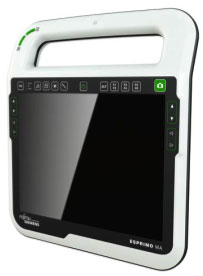On November 18, 2008 -- Fujitsu-Siemens introduced its Mobile Clinical Assistant, which they call a "Personal Healthcare Assistant," not under the long established line of Stylistic Tablet PCs, but under the "Esprimo" name used for some of their desktop PCs. Like the Motion Computing C5 and the recently introduced Panasonic H1, the Fujitsu-Siemens Esprimo MA is based on Intel's mobile clinical assistant (MCA) platform that was introduced in February of 2007 together with the Motion C5. The idea behind MCAs is to create mobile computers designed specifically for healtcare where light weight, spill-resistance, tolerance to the occasional drop and, most importantly, quick and easy disinfection matter.
 Despite being perhaps the most influential pioneer in pen tablets, Fujitsu let almost two years pass until it unveiled the Esprimo MA, giving it ample time to study Motion Computing's offering and how the healthcare market reacted to it. Two years are also almost an eternity in the fast-moving electronics field, and so one would expect the Esprimo to be technologically state-of-the-art (it is) as well as improving in some ways on the original MCA concept (not so much).
Despite being perhaps the most influential pioneer in pen tablets, Fujitsu let almost two years pass until it unveiled the Esprimo MA, giving it ample time to study Motion Computing's offering and how the healthcare market reacted to it. Two years are also almost an eternity in the fast-moving electronics field, and so one would expect the Esprimo to be technologically state-of-the-art (it is) as well as improving in some ways on the original MCA concept (not so much).
The overall design of a MCA is pretty much a given as long as a manufacturer agrees with Intel's platform: a 10.4-inch display in a slender tablet with an integrated handle. Fujitsu didn't stray from the concept and came up with a very elegant implementation. The idea behind the large integrated handle, I suppose, is that it makes an MCA easy to handle and also easy to remove from its dock. The Esprimo MA measures 10.3 x 11.3 inches and is 1.4 inches thick, making for a slender profile, though still thicker than the Motion C5. The machine, according to its spec sheet, weighs 2.9 pounds, and that is 10-15% less than the competition, though we'd like to confirm that ourselves.
Technologywise, Fujitsu chose the 1.6GHz Intel Atom Z530, a very miserly processor with a thermal design power of just two watts. It packs a little less punch than the Panasonic H1's 1.86MHz Atom Z540. Storagewise, Fujitsu offers several options. You can go either with a speedy 1.8-inch 5400rpm 120GB hard disk, a 64 or 128GB 1.8-inch solid state disk, or a 16GB IDE CF module. RAM is currently limited to 1GB, though Fujitsu mentions 2GB with "future memory models." For disinfection reasons, there is no onboard connectivity other than a dual SmartCard reader and a docking connector. The 10.4-inch LCD has both a touc screen and a digitizer. There is no reference to backlight brightness or sunlight viewability. Battery life is approximately four hours and the battery is hot-swappable.
MCAs are designed as data capture device and so Fujitsu-Siemens offers the Esprimo MA with an integratd 2-megapixel camera as well as optional 1D/2D bardcode reader and 13.56 MHz RFID reader. There is onboard Bluetooth and 802.11b/g/n WiFi, as well as optional UMTS/HSUPA 3G wireless support. Connectivity through the port replicator includes three USB 2.0 ports, a video-out port and an RJ45 LAN jack.
As far as ruggedness goes, Fujitsu lists IP54 sealing (dust-proof and protected against water spray from all directions) but no other environmental specs. The company points out that the Esprimo MA is an "easy to sterilize, waterproof, shockproof, robust housing, low surface temperature, fanless design."
From an ergonomic and handling standpoint, the device has cursor control buttons on each side of the display, as well as utility keys and six function keys for quick access to commonly used functions and applications. There is also a green camera button to take snapshots.
The MCA concept stresses Infection control is a major issue in clinical settings, and the Esprimo MA's smooth, fanless design with a flush-mounted display seems to lend itself to easy disinfection. There are also no ports or other opnings where bacteria and other bad guys can hide (though Fujitsu mentions Kensington lock support, which would mean an opening).
Coming shortly after Panasonic's announcement of the Toughbook H1, two of the major rugged/tablet manufacturers have now joined market pioneer Motion Computing in a quest to win over the potentially lucrative, yet tough to crack, healthcare/clinical market.



